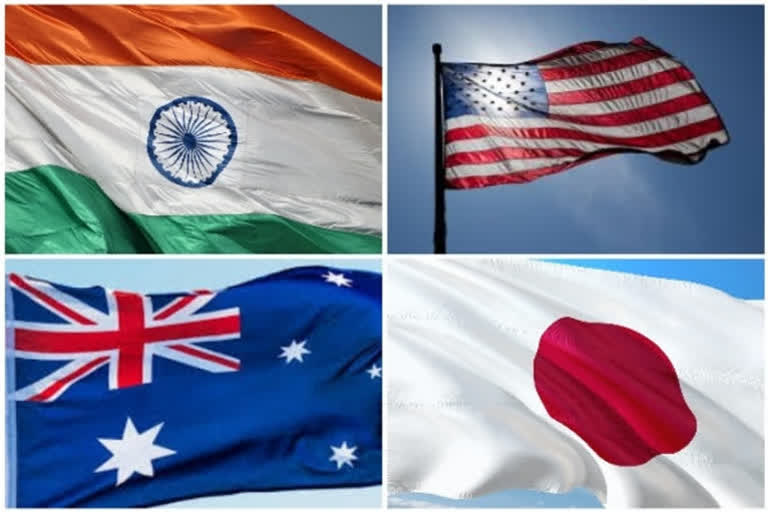New York: Nearly 17 years after the deadly 2004 tsunami, when outgoing Japanese Prime Minister Yoshihide Suga, Indian Prime Minister Narendra Modi, Australian Prime Minister Scott Morrison and US President Joe Biden meet September 24 for the first ever in-person leader level summit of the Quadrilateral Security Dialogue, it will mark a high point in a steady year-long elevation against the backdrop of China's growing economic and military strength and Covid-19.
Covid-19 vaccine production and distribution, supply chain resilience in critical and emerging technologies like semiconductors and 5G telecom networks are tipped to be top of the agenda.
For India's Prime Minister Narendra Modi, the Quad meeting will be bookended by a Covid-19 summit convened by Biden and Modi's own speech at the UN General Assembly, on Saturday.
The Covid-19 summit taps into the heart of Quad's most urgent priorities - and India's strengths in vaccine production. In the last 17 years, the Quad has taken a meandering path to its current prominence, with China's shadow being a central theme. In early 2021, Quad returned to the big stage after a nearly 10 year lull.
Also read: Australia-UK-US pact signals Asia-Pacific power shift
Beginning from its roots in crisis, here is a timeline that captures some of the key moments that have nudged the Quad into a closer embrace:
2004: The earliest framework for the Quad surfaced when the US, Japan, India and Australia formed a "core group" during their joint response to the 2004 tsunami.
2006: While in Tokyo, Indian Prime Minister Manmohan Singh announced that Japan and India wanted to begin a dialogue with other "like-minded countries in the Asia-Pacific region". In the same year, Japanese Prime Minister Shinzo Abe proposed an "Arc of Freedom and Prosperity".
2007: In August, Japanese Prime Minister Shinzo Abe's "Confluence of the Two Seas" speech sparked the ideological foundations for the Quad. Speaking in the Indian Parliament, he said, "The Pacific and the Indian Oceans are now bringing about a dynamic coupling as seas of freedom and of prosperity. A 'broader Asia' that broke away geographical boundaries is now beginning to take on a distinct form. Our two countries have the ability -- and the responsibility -- to ensure that it broadens yet further and to nurture and enrich these seas to become seas of clearest transparence."
2007: Quad countries held their first official meeting, in Manila. The Prime Ministers of India, Japan, and Australia met with then US Vice President Dick Cheney on the sidelines of the ASEAN Regional Forum (ARF). In the same year, within four months of the first meeting, Quad countries, alongwith Singapore, held an ambitious naval exercise in the Indian Ocean. But the downplaying went in parallel. Australia framed the Quad as a construct limited to trade and culture, India said the Quad had "no security implication."
2007: Prime Minister Shinzo Abe, a champion of the Quad grouping, resigned in September 2007. The Quad lost its most vocal champion.
2008: Soon after the 2007 Malabar exercise, Australia pulled out of the Quad. Subsequently, Australia was dropped from the 2008 Malabar exercise. More than a decade later, in a 2019 article, former Aussie PM Kevin Rudd recounted that in a full day of meetings with President George W. Bush and senior members of his cabinet in 2008, Quad wasn't raised even once by the American side. The grouping came apart. Between Quad 1.0 and its revival 10 years on, the four countries realigned with minilaterals. Japan and India became important fixtures in two such arrangements. A steady string of "2+2" bilaterals and trilaterals among foreign and defence ministers took off.
2011: After the Great East Japan Earthquake, Japan received massive support from the US, Australia, and India.
2012: Shinzo Abe returned to office and wasted no time in calling for a "democratic security diamond."
2013-2020: During this period, each of the Quad countries saw their share of China aggression. India dealt with four Chinese border agressions in 2103, 2014, 2017 and 2020.
2017: Japan announced plans to propose a top-level dialogue with the US, India and Australia. The stated intention was to counter Chinese aggression.
2017: Late this year, Australia began re-engaging with Quad partners. Senior officials met on the sidelines of the ASEAN summit in Manila. Biannual meetings continued at the "senior official" level. Also happening this year, a Japan-India civil nuclear cooperation agreement.
2019: First ministerial-level meeting of Quad 2.0.
2020: All four navies participated in their first joint exercise in over a decade, in November.
2021: In March, US President Joe Biden convened a virtual Quad meeting attended by Australian Prime Minister Scott Morrison, Indian Prime Minister Narendra Modi, and Japanese Prime Minister Yoshihide Suga. They formed working groups on Covid-19 vaccines, climate change, and technological innovation and supply-chain resilience.
2021: First leader level in-person summit, scheduled for September 24 at the White House.
IANS



